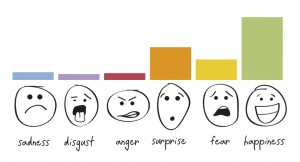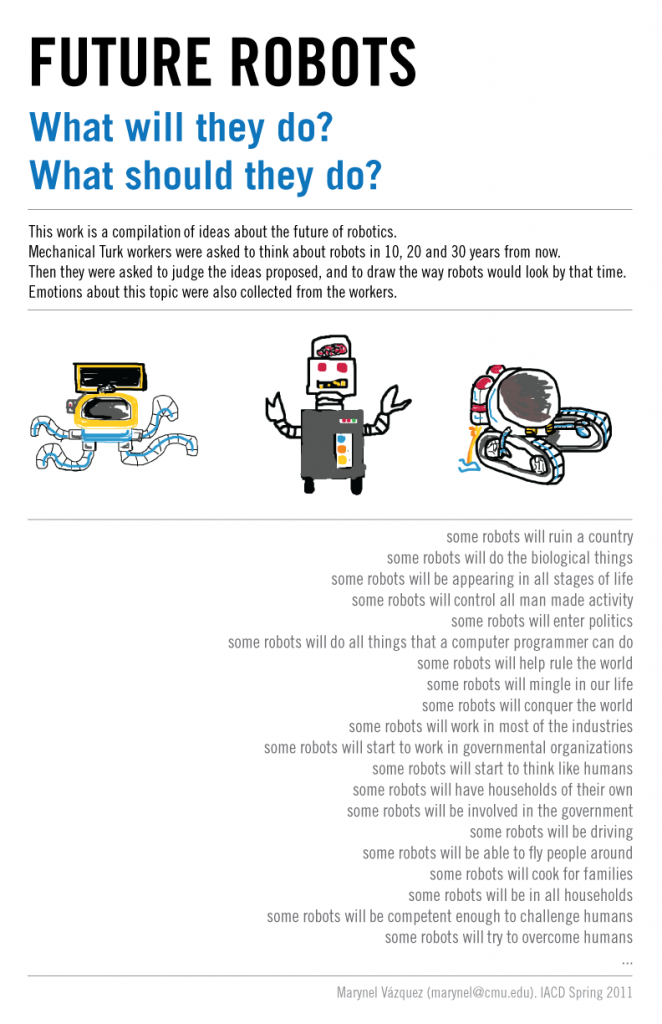Marynel Vázquez – Future Robots
|
|
627 crowdsourced ideas about robots in the future. |
INSPIRATION
As the field of robotics advances, more intelligent machines become part of our world. What will machines do in the future? What should they be doing? Even if we know what we would like machines to do, would other people agree?
To address these questions, I made a (crowd-sourced) book that compiles predictions and emotional responses about the role of robots in the future. The ideas collected about the use of robotics technology are mainly a product of popular culture, personal desires, beliefs and expectations.
We may not know what will happen in 10, 20 or 30 years from now, but we know what we want to happen, what we fear, what excites us. Is the robotics field expected to impact our future for better? Hopefully, the book product of this work will be a valuable sample of opinions.
BACKGROUND
Crowdsourcing has been used in the past for collecting creative human manifestations. One of the most famous projects that used Amazon’s Mechanical Turk for collecting drawings is Sheep Market by Aaron Koblin. The author of the project paid 2 cents to 10,000 Turkers to draw a sheep.
More recently, Björn Hartmann made Amazing but True Cat Stories. For this project, cat stories and drawings from Turkers were compiled in the form of a physical book. More details about this project can be found in Instructables.com.
In term of data collection, another important reference is the work of Paul Ekman on emotion classification. Ekman’s list of basic human emotions includes sadness, disgust, anger, surprise, fear, and happiness.
When collecting information from Turkers, a traditional scale for ordinal data is the Likert Scale. Different Likert-type scale response anchors have been studied by Wade Vagias. In particular, the traditional “level of agreement” scale turned out to be very useful for the Future Robots book.
THE PROCESS
CROWDSOURCING DATA
The ideas, opinions and drawings presented in this book were collected through Mechanical Turk. The data collection process went as follows:
- Workers were asked to complete two sentences: “In X years, some robots will…”; and “In X years, robots should…”. The possible values for X were 10, 20 and 30.
- For a given sentence from step 1, five workers had to agree or disagree with the statement that it was good for our future. Each of them had to select a feeling that would represent their major emotion if this sentence became true. The possible feelings they could choose from were Ekman’s basic emotions.
Workers also had to agree or disagree with the statement that they foreseed a bad future if the sentence became true. - A drawing of a robot was collected for each of the sentences from step 1.
The first step of the data collection process involved 627 sentences proposed by the workers (refer to this post for more information). Five different people had to give their opinions about each of these sentences in step 2, while only one person had to provide a drawing (see this other post for more details on steps 2 and 3 – there you can find the Processing.js code used to collect drawings -).
Note that different workers responded throughout the data collection process, though some completed many of the steps previously described.
MAKING THE BOOK
Mechanical Turk outputs comma-separated-value (.csv) files with the workers’ responses. Python was used to process all this data, and generate summarized files with results and simple statistics. Some of the data was later used by Processing to generate emotion charts such as the following:

A LaTeX class was created for the book after organizing all the images and graphics that were generated. This class was based on the classic book template, though it alters noticeably the title page, the headers, and the beginning of each section. Once the layout was set, a Python script was run to automatically create all the sections of the book as LaTeX input files.
The pdf version of the book can be downloaded from here. A zip file containing all LaTeX source can be downloaded from here.
VIDEO
CONCLUSIONS
My first impression was: the future is going to be bad! When I started reading the completed sentences proposed by the Turkers, I encountered many ideas that resembled famous Hollywood movies were the Earth and our race is in danger. Certainly, popular culture had an impact in the Future Robots book. Nonetheless, after generating the graphics for the book, my impressions drastically changed. A lot of happiness can be seen throughout the pages. Even though the data shows that there is concern about a bad future because of robots, the expectations of a good future are significant. From the ideas collected, for example, the expectation of a good future in 10 years has the following distribution:

If I had had more time for the project, I would have computed more statistics. For example, having a chart that compares the future in 10, 20 and 30 years from now would be a nice addition to the book. Also, an index of terms at the end of the book would be an easy and interesting way of exploring the data.
Another format for the project could have been a website. This option is very promising because, in general, it is easier to access for people than a physical book. A Processing visualization could be made to incorporate additional ways to analyze the data.
